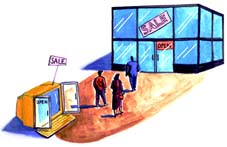With the proliferation of high-capacity, relatively low-cost PCs, an increasingly greater proportion of the population is logging onto the Internet each month. And as more people become wired, online retailing continues to grow, with sales volume expected to reach $133 billion by 2004. Buoyed by projections like this, electronic merchants are gearing up for a spree of online consumer spending. But their efforts may be misdirected, according to recent data from the
The study is based on 1999 data from the Wharton Virtual Test Market (WVTM), launched by the Forum in November 1997 as an ongoing survey of more than 25,000 Internet users. Inspired partly by the projected explosion of online B2C (business to consumer) activity, WVTM serves as a kind of electronic laboratory that can help gauge customer reactions to new products and strategies. It also offers an efficient way to estimate the size and composition of the online population.
In addition to recent data suggesting a slowdown in online consumer spending, results from a 1998 WVTM study reveal a significant dropout rate of online shoppers. In 1998, 15 percent of the consumers who bought online in 1997 did not buy online in 1998. "This group increased its use of catalogs by 20 percent, decreased time online from 14.7 hours to 12 hours, and used the Internet for work 16 percent less than average," says Gerald L. Lohse, Forum research director.
"Because the WVTM is providing one of the few sources of panel data measuring changes in the behavior of online consumers over time, it is particularly useful for understanding trends," says Lohse. The conclusions reached in his study, he says, should sound a wake-up call to online merchants.
"While average annual online spending by online buyers in this panel has increased significantly for three years in a row, the increase between 1998 and 1999 was not as large as that between 1997 and 1998," observes Lohse. "For example in 1997 the average online purchaser spent $420 a year; then in 1998 that figure more than doubled to $911. In 1999 though, the increase was less than 30%, rising to $1,136.
"If both online spending by individuals and the growth of the online audience are starting to slow down, then most forecasts of the size of the online business-to-consumer market over the next few years will have to be revised downward. This has huge implications for the business plans of many B2C dot-coms," he says.
Lohse describes two types of Internet users: the never buys (people who have never made online purchases and may never do so), and the dropouts (people who have made electronic purchases in the past, but have since sworn off Internet shopping).
"The never buys explain their lack of online activity with four major concerns," says Lohse. "First, there is a concern about online security, which has become even more sensitive with recent, well-publicized disruptions of major Web sites and the reported theft of hundreds of thousands of consumer credit card numbers from CD Universe’s site. Second, many of these people want the experience associated with buying merchandise from a bricks-and-mortar store, where they can touch the goods. The third most-cited reason is the delay between ordering the merchandise and the time it actually arrives, and the fourth reason is a bad online shopping experience that they heard about and that soured them on the concept."
Lohse also offers explanations for the behavior of the dropouts. "Number one, they say they receive too much spam (unwanted e-mail) following online purchases; number two is a low level of trust when it comes to online retailers. The third most-cited reason is a high level concern about third-party monitoring." Some sites, he says, place small text files called ‘cookies’ into a user’s computer that log and report back the sites that the user subsequently visits. Lohse points out, however, that while dropouts register the most concern about issues like secure encryption, they are in fact among the least knowledgeable about advances in such safeguards as secure socket layers and encryption technology.
Meanwhile, the Forum on Electronic Commerce weighed in on another topic of interest to Internet companies and consumers: price competition.
"Economists and the general public have thought that the rise of e-commerce would cause prices to go down," Lohse says. "Search engines make it easy for the consumer to compare what firms charge, and should force companies to match prices with their competitors, damaging everyone’s profitability."
But, in fact, that’s not what happened.
"At the May 1999 meeting of the Wharton Forum on Electronic Commerce, four research studies presented strategies that allow firms to charge premium prices online, and gave examples of online sellers that are using these strategies," notes Lohse. "Moreover, the studies found little evidence that online consumers shop around for cheap prices."
Even in markets where prices are expected to be similar, companies are still making sales at substantially different price points, according to a June 1999 paper by Wharton professors Eric K. Clemons and Lorin Hitt, and Il-Horn Hann of Carnegie Mellon University, GSIA. In the paper, "The Nature of Competition in Electronic Markets: An Empirical Investigation of Online Travel Agent Offerings", the authors found that even after accounting for differences in ticket quality, airline ticket prices varied by as much as 18% between different online ticket agents.
As for trends in Internet usage, other Internet consultants are just beginning to find results similar to the Forum’s, notes Lohse. He cites a recent report by the Internet database marketing company Cyber Dialogue, which also shows that the growth rate of the Internet audience is starting to slow down in the United States.
So what’s the bottom line for electronic retailers?
"
Online retailers will have to provide significant incentives to encourage dropouts to buy online again," says Lohse. "The research shows that the Internet population is already starting to look more and more like the general population. Therefore, companies will have to plan their Web site design for an audience that has a lower income, is less Web savvy, less educated, and less tolerant of new technology."


